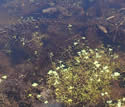Callitriche palustris (Vernal Water-starwort)
| Also known as: | Spring Water-starwort, Narrow-fruited Water-starwort, Common Water-starwort |
|---|---|
| Genus: | Callitriche |
| Family: | Plantaginaceae (Plantain) |
| Life cycle: | perennial |
| Origin: | native |
| Habitat: | part shade, sun; wet; shores, wet ditches, wet depressions, streams, rivers, marshes, swamps, rock outcrops |
| Bloom season: | May - August |
| Plant height: | 2 to 12 inches |
| Wetland Indicator Status: | GP: OBL MW: OBL NCNE: OBL |
| MN county distribution (click map to enlarge): |  |
| National distribution (click map to enlarge): |  |
Pick an image for a larger view. See the glossary for icon descriptions.
Detailed Information
Flower: 
![[photo of flowers]](/udata/r9ndp23q/aquatic/callitriche-palustris-072219-s3-t.jpg) Flowers lack petals, are tiny and inconspicuous, nestled in the leaf axils along much of the stem, with separate male and female flowers on the same plant (monoecious), often one male and one female in one axil and a female in the opposite axil. Male flowers have have a single yellow-tipped stamen, females have 2 styles. At the base of the flower is a scale-like bract that may or may not persist.
Flowers lack petals, are tiny and inconspicuous, nestled in the leaf axils along much of the stem, with separate male and female flowers on the same plant (monoecious), often one male and one female in one axil and a female in the opposite axil. Male flowers have have a single yellow-tipped stamen, females have 2 styles. At the base of the flower is a scale-like bract that may or may not persist.
Leaves and stems: 

![[photo of leaves]](/udata/r9ndp23q/aquatic/callitriche-palustris_0815_170648-t.jpg) Leaves are opposite with pairs arranged at right angles to the pairs above and below (decussate), connected at the base around the stem (connate), and variable in shape. Submersed leaves are linear and ribbon-like, 1-veined, up to 1 inch (2.5 cm) long, up to 1 mm wide, notched at the tip, and stalkless. Floating leaves are more spoon or spatula-shaped, 3-veined, up to 3/8 inch (1 cm) wide, toothless, mostly rounded at the tip, tapering at the base. In between are transitional leaves that are commonly narrowly club-shaped. Leaves on plants that are land-locked may be more oblong-elliptic. Stems are green and smooth.
Leaves are opposite with pairs arranged at right angles to the pairs above and below (decussate), connected at the base around the stem (connate), and variable in shape. Submersed leaves are linear and ribbon-like, 1-veined, up to 1 inch (2.5 cm) long, up to 1 mm wide, notched at the tip, and stalkless. Floating leaves are more spoon or spatula-shaped, 3-veined, up to 3/8 inch (1 cm) wide, toothless, mostly rounded at the tip, tapering at the base. In between are transitional leaves that are commonly narrowly club-shaped. Leaves on plants that are land-locked may be more oblong-elliptic. Stems are green and smooth.
Fruit: 
![[photo of developing fruit]](/udata/r9ndp23q/aquatic/callitriche-palustris-20230814-s2-t.jpg) Fruit is somewhat heart-shaped, .8 to 1.4 mm long, usually longer than wide, blackish at maturity, 4-parted with a distinct groove between each of the 4 seeds. Seeds are covered in tiny pits, more or less arranged in lines, and have a narrow, slightly bumpy wing or ridge along the top edge, though this wing is often obscure and sometimes absent, and the arrangement of pits can be difficult to discern even under magnification but is probably easiest to see around the wing.
Fruit is somewhat heart-shaped, .8 to 1.4 mm long, usually longer than wide, blackish at maturity, 4-parted with a distinct groove between each of the 4 seeds. Seeds are covered in tiny pits, more or less arranged in lines, and have a narrow, slightly bumpy wing or ridge along the top edge, though this wing is often obscure and sometimes absent, and the arrangement of pits can be difficult to discern even under magnification but is probably easiest to see around the wing.
Notes:
Callitriche palustris is one of the most common aquatic species in the world and will grow almost anywhere it's seasonally or continually wet. In Minnesota it's been found in sandy, gravelly, muddy and mucky soils, in wet ditches, bogs, marshes, swamps, pools in rock outcrops, prairie and woodland swales, as well as lakes, ponds, streams and rivers, in slow or fast-moving water. It's considered amphibious, persisting in terrestrial forms as well as aquatic forms.
Of the 3 Callitriche species in Minnesota, it is most likely to be confused with C. heterophylla, a rare species of rock outcrops in our southwest counties and protected bays of lakes in the northeast. They can be distinguished most reliably by the fruit: C. heterophylla fruits usually do not exceed 1 mm in length, the groove between seeds is obscure or absent as is the wing along the top edge, and the pits are not arranged in lines. C. hermaphroditica, the third species, lacks floating leaves, leaf pairs are not connected at the base, and seeds are more broadly winged, the wing extending to the base.
Native Plant Nurseries, Restoration and Landscaping Services ↓
More photos
 submersed Vernal Water-starwort
submersed Vernal Water-starwort land-locked Vernal Water-starwort
land-locked Vernal Water-starwort loose patch of Vernal Water-starwort
loose patch of Vernal Water-starwort a mat of Vernal Water-starwort
a mat of Vernal Water-starwort Callitriche palustris with Myriophyllum verticillatum
Callitriche palustris with Myriophyllum verticillatum mature fruit
mature fruit
Photos by K. Chayka taken in Cook, Lake and St. Louis counties. Photos by Peter M. Dziuk taken in Carlton and Kanabec counties.
Comments
Have you seen this plant in Minnesota, or have any other comments about it?






